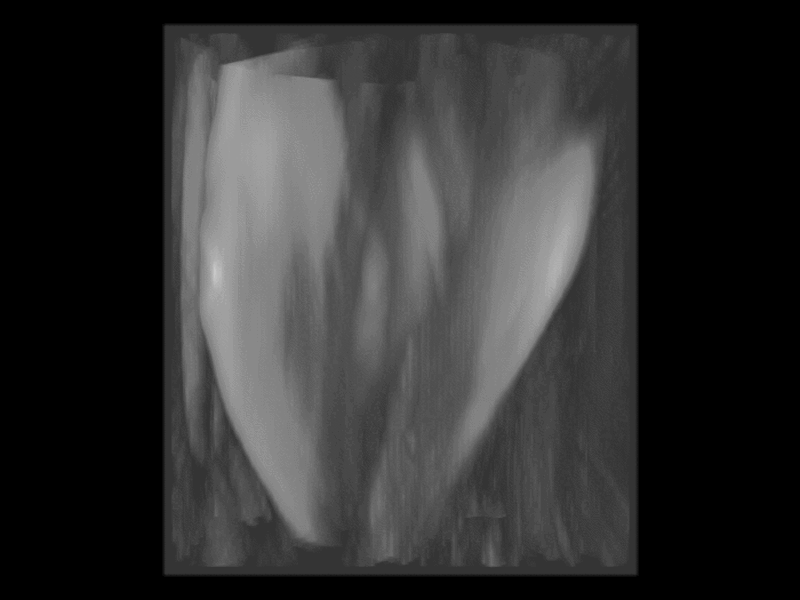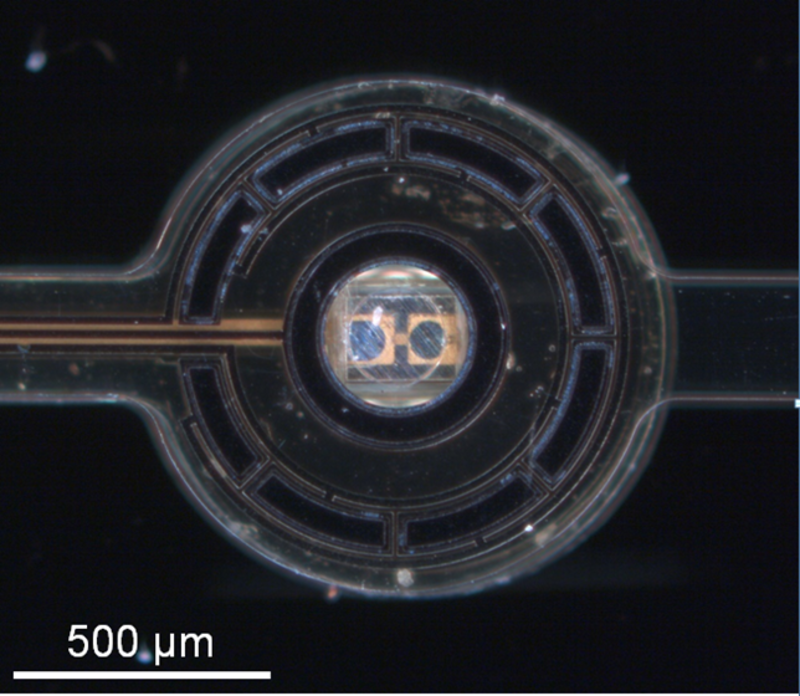Bioinstrumentation / Experimental Imaging
The Bioinstrumentation / Experimental Imaging Group develops and applies specialised equipment for cardiovascular research. This is required as often our questions cannot be addressed with off-the-shelf solutions. To this end, we have facilities for prototyping of mechanical and electrical components, and expertise in sensors, imaging, signal processing, control systems and user-interfacing.
Optoacoustic imaging
Currently there is no way to directly image the electrical activity in the heart in 3D in a tissue non-destructive manner. Optoacoustic imaging is a method where laser pulses are used to excite tissue, resulting in thermoelastic expansion of chromophores with the tissue and subsequently to generation of a pressure wave that can be recorded by ultrasound. By using tomographic techniques the exact location of the chromophores within the tissue can be identified. Optoacoustic imaging, by combining the advantages of fluorescent imaging with the penetration depth of ultrasound, holds the potential to enable measurement of cardiac electrophysiology in 3D. In collaboration with partners in the UK, USA, Switzerland and Germany we are currently testing voltage-sensitive optoacoustic probes and imaging systems for the ability to make these measurements.
Optical Mapping
While optoacoustic imaging holds great promise to measure cardiac electrophysiology, optical mapping is a relatively mature technique enabling the measurement of changes in cell function (such as membrane voltage and ion concentration) at high spatial and temporal resolution albeit with the limitation of only measuring these at the surface or near-surface of the tissue. We have recently developed a panoramic imaging system where, by using a series of mirrors, we can image the epicardial surface of whole hearts with a single camera. This is being further developed to allow correlation of electrical conduction across the epicardium with the underlying tissue structure using advanced light-sheet based imaging methods. The optical mapping system is used in a number of projects including investigating the mechanisms underlying arrhythmia formation in ischaemia/reperfusion injury and the role of the intracardiac nervous system in arrhythmia formation.
Fig. 2: Panoramic imaging system for optical mapping of membrane voltage and calcium while simultaneously measuring mechanics with ultrasound.
Cardiac pacing
We can also combine optical mapping with tools for optical control of function, via light-activated ion pumps and channels. These tools open up doors towards fully light-controlled studies of cardiovascular function in both health and disease. An example of their use is for optical pacing, where the heart can be paced by shining light on it instead of passing an electric current through it. In principle any method resulting in a sufficiently large flow of current into a set number of cardiac cells is sufficient to pace the heart, thus tapping the heart can also pace it via stretch-activated channels. This mechanical pacing is potentially interesting in the emergency setting of primary asystole where the heart is not beating and there is no specialized care nearby allowing rapid electrical pacing. In this setting, CPR is the best option, however the output from contractions is relatively low, thus the ability to pace the heart by just tapping on the chest is attractive. Unfortunately, mechanical pacing is not sustainable with initial experiments demonstrating a loss in the ability to pace after 50 to 100 beats (Quinn et al., 2016). To investigate how and why this occurs we have, in collaboration with the technical faculty (IMTEK), developed a system where we can use electrical, mechanical and optical pacing at the same location and rapidly switch between techniques to better understand the limitations of such pacing.
Fig. 3: Tip of an optrode-probe comprising a 270 μm x 270 μm LED in the centre with surrounding electrodes.
- Giardini F, Olianti C, Marchal GA, Campos F, Romanelli V, Steyer J, Madl J, Piersanti R, Arecchi G, Vanaja IP, Biasci V, Rog-Zielinska EA, Nesi G, Loew LM, Cerbai E, Chelko SP, Regazzoni F, Loewe A, Bishop MJ, Mongillo M, Kohl P, Zaglia T, Zgierski-Johnston CM, Sacconi L. Correlative imaging integrates electrophysiology with three-dimensional murine heart reconstruction to reveal electrical coupling between cell types. Nat Cardiovasc Res 2025/in press
- Mohr T, Schiffer M, Ramanujam D, Carls E, Zgierski-Johnston CM, Kok T, Niemann P, Geisen C, Kohl P, Engelhardt S, Fleischmann BK, Roell W. Efficient in vivo targeting of the myocardial scar using Moloney murine leukaemia virus complexed with nanoparticles. J Physiol 2025/in press
- Chleilat E, Walz TP, Quinn TA, Kohl P, Zgierski-Johnston CM. Perivascular excitation tunnelling as a novel mechanism of cardiac reperfusion arrhythmias. bioRxiv 2023
- Fernández MC, Wülfers EM, Madl J, Perez Feliz S, Kohl P, Zgierski-Johnston CM, Schneider-Warme F. 3D structure of fibroblasts and macrophages in the healthy and cryo-ablated heart. bioRxiv 2023
- Becker C, Hardarson J, Hoelzer A, Schulz T, Reichl C, Burton NC, Schuler T, Kohl P, Zgierski-Johnston C. Evaluation of cervical lymph nodes using multispectral optoacoustic tomography: a proof-of-concept study. Eur Arch Otorhinolaryngol 2023/280:4657-64
- Johnston CM, Rog-Zielinska EA, Wülfers EM, Houwaart T, Siedlecka U, Naumann A, Nitschke R, Knöpfel T, Kohl P, Schneider-Warme F. Optogenetic targeting of cardiac myocytes and non-myocytes: Tools, challenges and utility. Prog Biophys Mol Biol 2017/130:140-149
- Sassu E, Tumlinson G, Stefanovska D, Fernández MC, Iaconianni P, Madl J, Brennan TA, Koch M, Cameron BA, Preissl S, Ravens U, Schneider-Warme F, Kohl P, Zgierski-Johnston CM, Hortells L. Age-related structural and functional changes of the intracardiac nervous system. J Mol Cell Cardiol. 2023 187:1-14
- Lewetag RD, Nimani S, Alerni N, Hornyik T, Jacobi SF, Moss R, Menza M, Pilia N, Walz TP, HajiRassouliha A, Perez-Feliz S, Zehender M, Seemann G, Zgierski-Johnston CM, Lopez R, Odening KE. Mechano-electrical interactions and heterogeneities in wild-type and drug-induced long QT syndrome rabbits. J Physiol. 2023/Epub ahead of print.
- Kohl P, Zgierski-Johnston CM. Assessment of Tissue Viability by Functional Imaging of Membrane Potential. Methods Mol Biol. 2023/2644:423-34
- Han B, Trew M, Zgierski-Johnston CM. Cardiac Conduction Velocity, Remodeling and Arrhythmogenesis. Cells 2021/10:2923
- Zgierski-Johnston CM, Ayub S, Fernández MC, Rog-Zielinska EA, Barz F, Paul O, Kohl P, Ruther P. Cardiac pacing using transmural multi-LED probes in channelrhodopsin-expressing mouse hearts. Prog Biophys Mol Biol 2020/154:51-61
Team

Dr. Callum Zgierski-Johnston
Head of section

Leonardo Sacconi, PhD
Senior Scientist

Jana Ebeling

Gyuwon Lee
E-Mail: gyuwon.lee@uniklinik-freiburg.de

E-Mail: bo.han@uniklinik-freiburg.de

Anna-Lena Herm

Thomas Kok
E-Mail: thomas.kok@uniklinik-freiburg.de

Dr. Tony Rubio
E-Mail: tony.rubio@uniklinik-freiburg.de

Collin Snitchler






